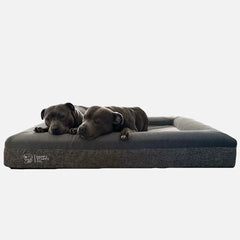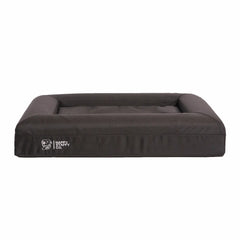Post-surgery recovery can be a challenging time for dogs, requiring special care to ensure optimal healing and comfort. While medications and follow-up veterinary visits play a critical role, the choice of bedding is equally important. Orthopedic beds provide essential support, especially for dogs recovering from surgical procedures involving bones, joints, or muscles. These beds are specifically designed to alleviate pressure points, promote circulation, and reduce pain, making them a crucial component of a comprehensive recovery plan.
The market for pet beds has evolved significantly, with orthopedic options now available in various sizes, materials, and support levels. For post-surgery care, choosing the right orthopedic bed can significantly impact a dog's recovery, reducing discomfort and preventing complications such as bed sores or joint stiffness. Whether dealing with hip dysplasia, spinal injuries, or ligament repairs, selecting a high-quality orthopedic bed tailored to the dog's specific needs can enhance overall recovery outcomes.
At Happy Staffy, we understand the importance of choosing the right orthopedic bed for post-surgery recovery. Learn about the key benefits of orthopedic beds, how to select the best one based on your dog’s condition, and essential maintenance tips to ensure lasting comfort and support. Expert recommendations and considerations will also be included to further aid in your dog’s rehabilitation journey.
Key Takeaways:
-
Orthopedic beds support dogs recovering from surgery by relieving pressure and reducing pain. High-density memory foam helps maintain joint alignment, improves circulation, and protects healing areas from strain.
-
Dogs recovering from spinal, hip, or joint surgeries benefit from tailored orthopedic features. Beds with neck bolsters, firm foam, or waterproof, hypoallergenic covers enhance healing comfort and reduce complications.
-
Orthopedic beds with cooling gel layers and breathable fabrics keep dogs comfortable during recovery. These features prevent overheating, manage moisture, and protect sensitive skin from irritation or infection.
-
Maintaining an orthopedic bed is essential for long-term support. Regularly wash covers, vacuum surfaces, and inspect foam for sagging to ensure the bed continues to provide the right level of comfort.
-
Dogs need the right bed based on their surgery, size, and mobility. Low-profile, easy-access beds suit dogs with limited movement, while vet-recommended designs help ensure proper post-op recovery and well-being.
Understanding Orthopedic Beds and Their Benefits

Orthopedic beds are specifically designed to provide targeted support to areas prone to pressure and discomfort, such as the spine, hips, and joints. These beds are typically constructed using high-density memory foam, which conforms to the dog’s body, distributing weight evenly and reducing strain on sore or healing areas. For dogs recovering from surgery, this level of support can prevent further injury and promote quicker recovery.
Key Benefits of Orthopedic Beds:
-
Enhanced Comfort and Pain Relief: Orthopedic beds provide superior cushioning that conforms to the dog’s body, distributing weight evenly and reducing pressure on sore areas. This minimises discomfort, particularly for dogs recovering from joint or muscle surgery.
-
Reduced Joint Strain and Pressure: By alleviating pressure points, these beds prevent further strain on sensitive joints, promoting relaxation and reducing the risk of complications during the healing process.
-
Improved Circulation and Blood Flow: Memory foam beds support proper circulation by evenly distributing weight, preventing blood flow restrictions that could impede recovery.
-
Spinal Alignment Support: Maintaining spinal alignment is vital for dogs recovering from spinal injuries or surgeries. Orthopedic beds with added neck bolsters or firm foam help keep the spine properly aligned while resting.
-
Enhanced Comfort and Pain Relief: Orthopedic beds provide cushioning that conforms to the dog’s body shape, reducing pressure on surgical sites and easing discomfort. This support is particularly vital for dogs with joint or muscle injuries, as it prevents further strain and allows for more restful sleep.
-
Reduced Joint Strain and Pressure: By evenly distributing body weight, orthopedic beds minimise pressure points, preventing further stress on sensitive joints. This feature is crucial for post-surgery recovery, as it helps maintain proper alignment and reduces the risk of complications.
-
Improved Circulation and Blood Flow: Memory foam beds support healthy blood flow by contouring to the dog’s body and alleviating areas of excessive pressure. Enhanced circulation accelerates healing and reduces swelling, benefiting dogs recovering from surgery.
-
Spinal Alignment Support: Orthopedic beds with neck bolsters or firm foam provide structural support that keeps the spine properly aligned. This is particularly beneficial for dogs recovering from spinal injuries or surgeries, as it prevents misalignment and promotes effective healing.
Additional Features of Orthopedic Beds:
-
Cooling Gel Layers to Prevent Overheating: These layers maintain a stable temperature, preventing overheating and reducing inflammation in post-surgical areas.
-
Breathable Covers for Optimal Airflow: Ventilated fabrics improve airflow, keeping the bed cool and minimising moisture buildup that could lead to skin irritations.
-
Hypoallergenic Materials to Reduce Allergens: Orthopedic beds often include hypoallergenic covers to protect sensitive skin, reducing the risk of allergic reactions during recovery.
-
Water-resistant Liners for Moisture Protection: Waterproof liners safeguard the foam from accidents or post-surgical drainage, preventing bacterial growth and preserving the bed’s structure.
-
Breathable Covers for Optimal Airflow: Designed with ventilated materials, these covers improve air circulation, preventing moisture buildup and keeping the bed fresh. Enhanced airflow also helps regulate temperature, contributing to overall comfort during recovery.
-
Hypoallergenic Materials to Reduce Allergens: Orthopedic beds made from hypoallergenic fabrics protect sensitive skin by minimising exposure to dust mites and allergens. This feature is particularly important for dogs with compromised immune systems or skin sensitivities.
Choosing the Right Orthopedic Bed Based on Surgery Type

The type of surgery your dog has undergone will largely determine the kind of orthopedic bed that best suits their needs. For instance, dogs recovering from spinal or neck surgeries may require beds with extra neck support or elevated bolsters. These features provide added cushioning for the neck and spine, preventing strain and promoting proper alignment during rest.
For dogs with hip dysplasia or joint replacements, beds with thick, high-density memory foam are ideal. These beds offer superior support to sensitive joints, preventing pressure buildup and aiding in pain management. Alternatively, dogs recovering from leg or knee surgeries may benefit from beds with removable covers, allowing for easy cleaning in case of post-surgical drainage or accidents.
In addition to the bed’s structure, consider the cover material. Hypoallergenic, waterproof covers are ideal for post-surgery recovery, as they prevent bacteria buildup and protect against leaks. The ability to easily remove and wash the cover ensures that the recovery area remains clean and sanitary, minimising the risk of infection.
Maintenance Tips for Orthopedic Beds
Maintaining an orthopedic bed properly is essential to ensure it continues providing the necessary support throughout the recovery period. Start by regularly washing the bed’s cover to prevent bacteria buildup. Opt for machine-washable covers that are easy to clean, especially those with antimicrobial properties that deter bacteria and odor.
Inspect the foam for signs of wear or sagging. Memory foam, while durable, can lose its shape over time, compromising its supportive qualities. Rotate the foam periodically to prevent uneven wear and consider replacing the foam insert if it no longer provides adequate support.
Vacuum the bed’s surface to remove dirt, hair, and dander, as these can accumulate and affect the bed’s comfort and cleanliness. For beds with cooling gel layers, avoid exposing them to direct sunlight for extended periods, as heat can deteriorate the gel material and reduce its effectiveness.
Lastly, consider investing in a water-resistant liner to protect the foam from moisture, especially if your dog is prone to accidents or post-surgical drainage. Keeping the foam dry not only maintains its integrity but also prevents mold and mildew growth, which can pose health risks to recovering dogs.
Expert Recommendations and Considerations

Selecting the right orthopedic bed involves more than just choosing a comfortable surface. Consulting with a veterinarian can provide valuable insights into the specific support requirements for your dog’s post-surgery recovery. For instance, dogs recovering from spinal surgery may benefit from memory foam beds with added neck bolsters, while those with hip dysplasia might require firmer foam to maintain joint alignment.
Additionally, consider your dog’s sleeping habits and mobility when selecting a bed. Dogs that tend to sprawl out may need a larger bed with ample cushioning, while smaller breeds recovering from surgery may feel more secure in beds with elevated sides. If your dog struggles with getting in and out of bed due to limited mobility, consider a low-profile orthopedic bed that is easy to access.
Monitoring your dog’s response to the bed is equally important. Signs of discomfort, such as restlessness, difficulty getting up, or excessive licking of joints, may indicate the need for a different bed type or additional padding. Adjusting the bedding setup based on your dog’s recovery progress ensures optimal comfort and support throughout the healing process.
Creating a Supportive Recovery Environment

Orthopedic beds play an essential role in post-surgery recovery for dogs, offering targeted support that alleviates pressure, reduces pain, and promotes healing. Durable and designed to withstand common behaviours like scratching, chewing, and even occasional accidents like peeing, these beds provide a reliable resting spot during the recovery period. By selecting a bed tailored to your dog’s specific surgical needs and maintaining it with regular cleaning and inspection, you can create a comfortable, supportive environment that fosters optimal recovery.
At Happy Staffy Co., we offer a selection of orthopedic beds designed to provide the best possible support for your dog’s recovery. Contact us to find the ideal bed that suits your dog’s condition and ensure a safe, comfortable healing space.



